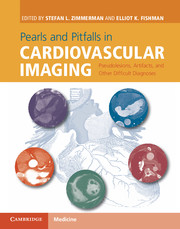 Pearls and Pitfalls in Cardiovascular Imaging
Pearls and Pitfalls in Cardiovascular Imaging from Section 9 - Mesenteric vascular
Published online by Cambridge University Press: 05 June 2015
Imaging description
CT angiography (CTA) provides a non-invasive method for the diagnosis of segmental arterial mediolysis (SAM), a rare non-atherosclerotic and non-inflammatory arterial disease. Smooth muscle degeneration of the outer layer of the media occurs primarily in the visceral branches of the abdominal aorta, leading to intramural hemorrhage and periadventitial fibrin deposition. Contrast-enhanced arterial phase axial CT imaging in combination with multiplanar reconstructions and maximal intensity projections are useful imaging tools. Imaging findings include caliber irregularities of the splanchnic arteries including a “string of beads” appearance, aneurysm formation, or dissection (Figures 79.1, 79.2, 79.3 and 79.4). Conventional angiography may be reserved for equivocal findings seen on CTA or MRA and for treatment.
Importance
Mortality related to SAM is about 26% and may be due to aneurysm rupture and subsequent hemorrhage. Due to the lack of histopathologic confirmation of this disease in most cases, characteristic imaging findings may be the only way to diagnose this entity in patients with otherwise unexplained abdominal pain and gastrointestinal bleeding after excluding other possible etiologies. Axial and multiplanar CTA may help in the diagnosis while catheter angiography may be used for intervention.
Typical clinical scenario
SAM usually affects middle-aged patients and presents with abdominal pain, gastrointestinal hemorrhage, retroperitoneal hemorrhage or intracranial bleeding. Endovascular intervention has a high success rate while open surgical approach with vascular reconstruction may also be performed in select cases.
Differential diagnosis
Fibromuscular dysplasia (FMD), although considered a variant of SAM given the similar imaging findings, affects middle-aged women and involves primarily the renal and carotid arteries. Congenital conditions such as Ehlers–Danlos syndrome generally starts manifesting at a younger age while neurofibromatosis type 1 may cause vascular narrowing by mass effect from the surrounding neurofibromas easily seen on cross-sectional imaging. Mycotic aneurysms have a predilection for arterial bifurcations and will have surrounding inflammatory changes.
To save this book to your Kindle, first ensure [email protected] is added to your Approved Personal Document E-mail List under your Personal Document Settings on the Manage Your Content and Devices page of your Amazon account. Then enter the ‘name’ part of your Kindle email address below. Find out more about saving to your Kindle.
Note you can select to save to either the @free.kindle.com or @kindle.com variations. ‘@free.kindle.com’ emails are free but can only be saved to your device when it is connected to wi-fi. ‘@kindle.com’ emails can be delivered even when you are not connected to wi-fi, but note that service fees apply.
Find out more about the Kindle Personal Document Service.
To save content items to your account, please confirm that you agree to abide by our usage policies. If this is the first time you use this feature, you will be asked to authorise Cambridge Core to connect with your account. Find out more about saving content to Dropbox.
To save content items to your account, please confirm that you agree to abide by our usage policies. If this is the first time you use this feature, you will be asked to authorise Cambridge Core to connect with your account. Find out more about saving content to Google Drive.